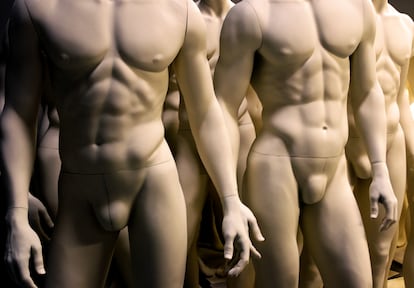From Finasteride to Invisalign: The (extreme) aesthetic cocktail of what makes a man sexy today
Hair loss pills, rejuvenating creams, orthodontics that align teeth and treatments that whiten them. Bodies are being eyeballed and worked on to make them more attractive and youthful and, according to experts, the trend has only just begun

Men’s medicine cabinets are increasingly resembling the pharmaceutical stockroom of the chronically ill. The male aesthetic norm — healthy and abundant hair, toned and voluminous muscles, well-defined jawline, straight and blindingly white teeth, smooth and glowing skin — requires fairly radical pharmacological and medical interventions to stimulate metabolism and cellular function. The perfect man is also medicated so as not to remain on the sofa, an understandable desire of a body after taking the necessary steps towards becoming aesthetically normative, optimized and productive, energetic, healthy and happy.
The old axiom of it being what’s inside that counts has morphed into a cult of cells, hormones, tissue oxygenation, insulin and glucose. This is harsh biological terminology, endowed with more prestige than merely lyrical cosmetic pursuits, but which seeks precisely the same goal: a specific, homogeneous aesthetic canon that for natural and genetic reasons is impossible to replicate without the help of a diverse therapeutic arsenal of molecules that require medical prescription, disciplined doses and schedules, and that can cause side effects capable of generating neurosis and hypervigilance when it comes to monitoring one’s vital signs.
Benefits of this barrage are meant to cause changes on cellular and metabolic levels that, presumably, will manifest in the hair bulb (located at the base of the hair follicle), in glowing skin and even in the decibels of one’s snores.
“All the men around me are taking Finasteride [a box of 30 pills can cost around $70], and I’m about to start,” confesses Ángel L., a Spaniard who recently saw his scalp peeking through a gap in his toupee. The finding launched him into a state of high alert and set off accelerated WhatsApp messaging traffic between Ángel and his inner circle. After all, the fight against alopecia can be seen as a matter of national dignity. According to the 2024 baldness map charted by World Population Review, Spain has the second-highest number of bald heads in the world, the first highest being in the Czech Republic.
Finasteride, a small orange pill, was approved in 1992 to treat prostate hyperplasia (thickening), but researchers observed an unexpected side effect among patients who used it: they regained much of their lost hair. Five years later, in 1997, its indication in the treatment of androgenetic alopecia was approved.

In 2020, Finasteride was 90th on the list of best-selling medicines in the United States, to the tune of more than eight million prescriptions; in the United Kingdom between 2021 and 2002, its medical prescriptions rose by 87%, and numbers on Google show that searches for the medication have consistently risen since 2004 and peaked in March 2023. You probably know many people who take it, although whether they volunteer that information is another matter entirely. Similar to hair implants, one’s passion for Finasteride is normally a silent matter. Let’s say it’s the last resort before throwing in the towel and buying a ticket to Turkey and making an appointment at Cristiano Ronaldo’s hair transplant clinic.
Protein, amino acid and biotin serums administered in clinics for $200 or more, depending on the blend and require patients to be attached to a drip for more than an hour, but they also promise to improve hair thickness and abundance. In the office of Dr. David Sampayo, an expert in hair health, many men work remotely, typing away on laptops while plugged into his serums of vitamin C, magnesium, zinc and biotin.
Another area of concern is the jaw and neck. Or more specifically, double chins and loose skin. Their treatment, called facial masculinization, revives the face’s angles and straight lines, starting at around $1,000. “It consists of applying fillers to middle and lower thirds of the face (cheekbones, chin and jaw), in order to achieve a square, angular face,” explains dermatologist Juanma Revelles. “Well-defined cheekbones and jawlines are perceived as masculine. With the passage of time, the retaining ligament loses its strength and allows fat layers to fall, one layer pushing down the next. We reposition them at different, strategic points so that the face continues to maintain its volume,” says Sampayo.

Forums on sites like looksmaxxing are codifying these practices via acronyms and jargon that establish the new golden ratios of a perfect male face: IPD refers to “interpupillary distance” (the distance between pupils); the “canthal tilt” measures the angle of the eyes and “mewing” is a tongue exercise geared towards toning the muscles around the jaw. The final goal is improving one’s SMV (“sexual market value”).
Invisalign’s clear aligners, in addition to the brand’s other products, are also taking up space in some men’s toiletry bags. But their use is no longer a matter of correcting imperfections, crooked teeth or wonky bites. Some men, apparently, already have aligned teeth, but are seeking absolute perfection when they put on the transparent aligners for 22 hours a day, gunning for a smile so perfect that it could have been spat out by a 3-D printer. These aides range from $2,650 to $9,000. Invisible orthodontics have become a multi-generational practice — members of alpha generation and boomers alike sport clear caps designed by the California company. Once one’s smile is aligned, there remains the matter of its hue, a subject that we addressed previously here at EL PAÍS. Popular aesthetic has mandated the necessity of a white so blinding that it doesn’t exist in the range of natural teeth coloring. Teeth whitening processes can run customers from $300 to $1,000 per treatment.
The well-informed may already be aware of Metformin, a classic treatment to control glucose that has morphed into a promising anti-aging medication, thanks to a 2014 clinical trial that found that patients with Type 2 diabetes who took the drug had a 38% longer life expectancy than those taking other anti-diabetes drugs, and 15% longer than the general population. Since then, many research trials have focuses on whether Metformin is the true fountain of youth.

“All the doctors who are experts in anti-aging medicine are taking Metformin,” said one specialist who prefers to remain anonymous, but who works at a large resort focused on regenerative medicine and longevity. Some studies show that Metformin activates the production of sirtuins, proteins that reduce oxidative stress in cells and promote DNA repair.
Weekly injections of Ozempic (which can cost nearly $1,000 per month without insurance), Wegovy ($1,350 for a 28-day supply) and Mounjaro ($1,000 to $2,000 per month) are, for those who can afford them, a great investment towards losing weight. Clinical trials with human subjects have shown that overweight individuals can lose up to 15% of their bodyweight through their use. And creatine (though it carries with it a real risk of kidney failure in some cases) is an open secret among those who are looking to build muscle mass and optimize their performance in the gym. Lovers of burpees, CrossFit and Stoic philosophy, take note.
These practices take advantage of a certain, widespread resistance to letting nature takes its course, a reluctance to resign oneself to aging according to the mandates of family genetics. My father went bald at 45, but perhaps I can do better? “Before, people wanted to grow old with dignity — now, they don’t want to grow old at all,” says Sampayo. It’s all about hacking both one’s genes and destiny via chemistry and technology.
One of the most extreme projects geared towards reversing biological age and achieving this particular aesthetic canon is that of 60-year-old Robert Nielsen, the main investor behind Altos Labs, a biotech company that investigates the process of resetting cells through epigenetic reprogramming, which to date has only been tested on mice in a well-known experiment carried out in 2006 by the winner of the Nobel Prize in Medicine, Shinya Yamanaka. Every day, Nielsen takes a dozen pills, among them Rapamycin (which appears to inhibit tumor growth), Metformin and taurine (a natural nutrient whose production decreases with age). Twice a year, he has a full-body MRI. He visits a dermatologist every three months and trains daily in an electrical stimulation suit to build muscle mass.
Bryan Johnson, biohacker and multimillionaire, is at the center of another extreme experiment. Having already celebrated his 46th birthday, he says he now has the body of an 18-year-old. He has invested more than two million dollars in the initiative, which he calls Project Blueprint. This is his life: he wakes up at 5 a.m. and has his last meal of the day at 11 a.m. Between the two, he must consume 2,250 calories, free of salt and sugar. He goes to bed at 8:30 p.m. He also takes 111 pills a day, including zinc, turmeric and lithium. He trains 45 to 60 minutes, seven days a week and plays tennis and basketball. He consumes 70 pounds of vegetables a month, mostly broccoli, cauliflower, garlic and ginger. His daily meals include the Green Giant shake, through which he takes in 54 supplements including spermidine, creatine and collagen peptides. After 4 p.m., he does not consume any drinks or liquids so as not to complicate his sleep and uses a machine to strengthen his pelvic floor and prevent urinary incontinence. He also wears an infrared light helmet every day in order to stimulate his scalp. According to an interview with Bloomberg, he uses seven facial creams on a daily basis, has a weekly acid peel, injects fat into his cheekbones and never sunbathes. After two years of this regimen, he says that his blood tests and physical exams are equivalent to those of an 18-year-old, and that his aging process has slowed down by 28%.
At this pace of aesthetic and biological intervention, in a decade, it may be difficult to guess a person’s age. There will only be young men with an imprecise number of years under their belt, sporting 3-D smiles and hair, lots of hair.
Sign up for our weekly newsletter to get more English-language news coverage from EL PAÍS USA Edition
Tu suscripción se está usando en otro dispositivo
¿Quieres añadir otro usuario a tu suscripción?
Si continúas leyendo en este dispositivo, no se podrá leer en el otro.
FlechaTu suscripción se está usando en otro dispositivo y solo puedes acceder a EL PAÍS desde un dispositivo a la vez.
Si quieres compartir tu cuenta, cambia tu suscripción a la modalidad Premium, así podrás añadir otro usuario. Cada uno accederá con su propia cuenta de email, lo que os permitirá personalizar vuestra experiencia en EL PAÍS.
¿Tienes una suscripción de empresa? Accede aquí para contratar más cuentas.
En el caso de no saber quién está usando tu cuenta, te recomendamos cambiar tu contraseña aquí.
Si decides continuar compartiendo tu cuenta, este mensaje se mostrará en tu dispositivo y en el de la otra persona que está usando tu cuenta de forma indefinida, afectando a tu experiencia de lectura. Puedes consultar aquí los términos y condiciones de la suscripción digital.
More information
Últimas noticias
Alain Aspect, Nobel laureate in physics: ‘Einstein was so smart that he would have had to recognize quantum entanglement’
Imelda Castro, the woman who wants to rule the cartel battleground of Sinaloa
The new victims of the Republican war on Obamacare: Millions hit by soaring health insurance premiums
A country divided on migrant rights: Some US states expand protections while others restrict them
Most viewed
- David King, chemist: ‘There are scientists studying how to cool the planet; nobody should stop these experiments from happening’
- Reinhard Genzel, Nobel laureate in physics: ‘One-minute videos will never give you the truth’
- Oona Chaplin: ‘I told James Cameron that I was living in a treehouse and starting a permaculture project with a friend’
- Sinaloa Cartel war is taking its toll on Los Chapitos
- Mexico completes its trade shift with the entry into force of tariffs on China and countries without trade agreements











































